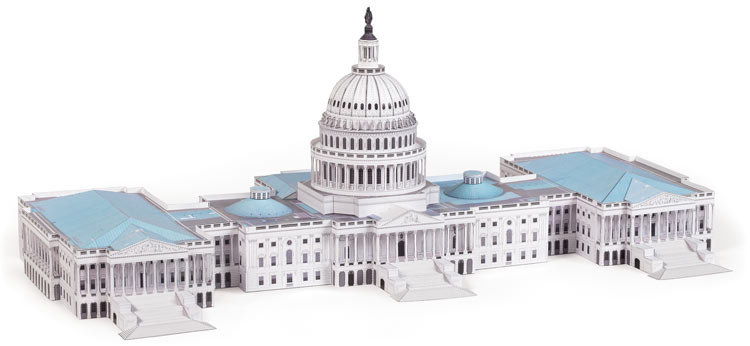
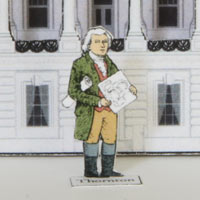 |
Dr. William Thornton was an amateur architect and inventor whose design won Thomas Jefferson's contest for plans of the new "Capitol" to be built on a small hill in the new District of Columbia. |
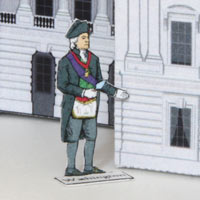 |
President George Washington laid the cornerstone of the new statehouse with pomp and circumstance in a grand Masonic procession and ceremony on September 18, 1793. |
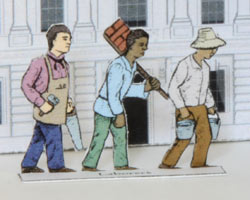 |
Both hired and slave laborers worked on building the foundations of the Capitol, laying bricks and shaping sandstone blocks for its exterior. Work progressed in fits and starts as funding was available, under a rushed schedule to finish by the fall of 1800 in time for the government's planned move from Philadelphia. |
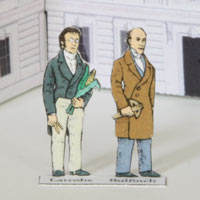 |
Benjamin Latrobe was hired as Architect of the Capitol in 1803. Finding problems in the previous construction, Latrobe redesigned the interior to the east-facing building we know today. One of his memorable contributions to architecture is his invention of American orders of Classical columns inspired by the natural world, such as tall rows of corn. Much of his work was destroyed, however, when the building was burned by the British in the War of 1812. Charles Bulfinch became Architect of the Capitol in 1818 and finally completed the central section of the building under a grand dome inspired by the Pantheon. |
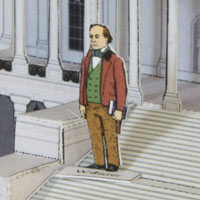 |
Daniel Webster served in the House of Representatives twice, the Senate twice, and as Secretary of State twice. Three runs for President were unsuccessful. He was celebrated in his time for his elegant oratory and powerful speeches in Congress, which were reprinted and reread for many years after his death in 1852. |
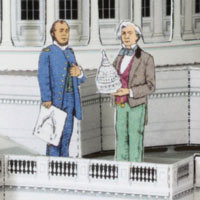 |
To accomodate the growing government, architect Thomas U. Walter designed new wings to the building. To balance the horizontal expansion, he also redesigned the central dome into a taller structure surrounded by a colonnade. President Millard Fillmore laid the cornerstone for the expansion of the building in 1851. Senator Jefferson Davis appointed Captain Montgomery C. Meigs as engineer on the project in 1853. Meigs supervised construction of the wings and the structure of the dome, one of the largest cast iron domes ever built. |
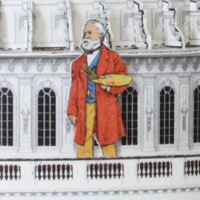 |
Captain Meigs hired Italian immigrant Constantino Brumidi to paint frescoes at the Capitol in 1854. His best-known works are the paintings around the rotunda and the Apotheosis of Washington at the top interior ceiling of the Capitol dome. |
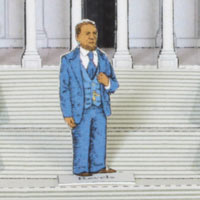 |
Hiram Rhodes Revels was the first African-American Senator, elected in 1870 representing Mississippi, the same seat that had been earlier occupied by Jefferson Davis. |
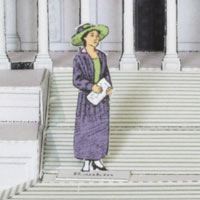 |
The first woman elected to Congress was Jeannette Rankin, representing Montana in 1916, and again in 1940. A pacifist, Rankin voted against the declaration of war against Germany in 1917, and was the only member of Congress to vote against the declaration of war against Japan in 1941. |
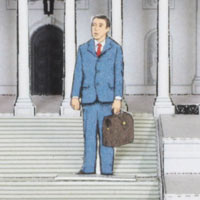 |
Jimmy Stewart plays the honest but naive junior Senator Jefferson Smith, newly arrived at the Capitol, in the 1939 film Mr. Smith Goes to Washington. |
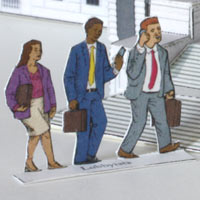 |
Lobbyists have long been a feature at the Capitol, seeking to persuade members of Congress to listen to the concerns of one industry or another. Despite the colorful legend that President Ulysses S. Grant coined the term to describe those hanging around in the Willard Hotel's smoke-filled lobby to talk to him, the word had been in use in England for many years before his time. |
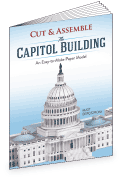 Order the Capitol Building model book
Order the Capitol Building model book
Dover Publications, 2017: ISBN 978-0-486-81474-2. Paper model ©Matt Bergstrom, Wurlington Press
